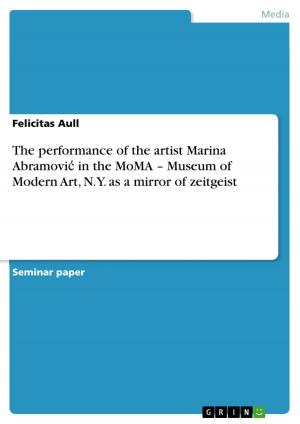'Together they would be complete' Female Doubles in C. P. Gilman's 'The Yellow Wall-Paper' and H. James's 'The Bostonians'
Nonfiction, Entertainment, Drama, Anthologies| Author: | Eva Maria Krehl | ISBN: | 9783640211456 |
| Publisher: | GRIN Publishing | Publication: | November 14, 2008 |
| Imprint: | GRIN Publishing | Language: | English |
| Author: | Eva Maria Krehl |
| ISBN: | 9783640211456 |
| Publisher: | GRIN Publishing |
| Publication: | November 14, 2008 |
| Imprint: | GRIN Publishing |
| Language: | English |
Examination Thesis from the year 2008 in the subject American Studies - Literature, grade: 1,0, University of Tubingen (Institut für Amerikanistik), 58 entries in the bibliography, language: English, abstract: The nineteenth century was in love with duality. A strict separation between the public and the private spheres, that at the same time meant sharply separated spheres of action for men and women, is only one expression of the general be-lief in fixed binary oppositions that characterized both American and British so-ciety in the Victorian era. Since the innate and natural difference between man and woman, as the most compelling duality, was similarly taken for granted, ni-neteenth-century society was also structured and determined by a rigid gender-role differentiation. It should hardly surprise us, then, that writings of the mid- to late-nineteenth century are especially preoccupied with the motif of the double. While this fasci-nation with double figures could on the one hand be accounted for with the Victo-rian belief in the essential duality of life, the motif's proliferation in works written at the turn of the century may also be interpreted as a symptom of the cultural transformation that dominated this era. In America, especially, the rapid growth of the nation following the Reconstruction period, together with the ensuing technological revolution, the rise of industrial capitalism, and the subsequent emergence of new social classes brought about a climate of change that stimulated both anxiety and expectation. These conflicting impulses contributed to a general feeling of fragmentation that, in literature, could best be expressed with the characters' self-division or self-duplication (cf. Miyoshi ix-xix). Grave anxieties, however, were also prompted by the changes women sought, for rigid gender lines were feared to dissolve by the 1880s with women's nascent emancipation and the emergence of the so-called 'new woman.' While political oratory and journalism had by then become an important factor in American society of the time, fe-male orators speaking out for equal rights, though growing in numbers, were still regarded an anomaly up until much later (cf. Levander 1-11).
Examination Thesis from the year 2008 in the subject American Studies - Literature, grade: 1,0, University of Tubingen (Institut für Amerikanistik), 58 entries in the bibliography, language: English, abstract: The nineteenth century was in love with duality. A strict separation between the public and the private spheres, that at the same time meant sharply separated spheres of action for men and women, is only one expression of the general be-lief in fixed binary oppositions that characterized both American and British so-ciety in the Victorian era. Since the innate and natural difference between man and woman, as the most compelling duality, was similarly taken for granted, ni-neteenth-century society was also structured and determined by a rigid gender-role differentiation. It should hardly surprise us, then, that writings of the mid- to late-nineteenth century are especially preoccupied with the motif of the double. While this fasci-nation with double figures could on the one hand be accounted for with the Victo-rian belief in the essential duality of life, the motif's proliferation in works written at the turn of the century may also be interpreted as a symptom of the cultural transformation that dominated this era. In America, especially, the rapid growth of the nation following the Reconstruction period, together with the ensuing technological revolution, the rise of industrial capitalism, and the subsequent emergence of new social classes brought about a climate of change that stimulated both anxiety and expectation. These conflicting impulses contributed to a general feeling of fragmentation that, in literature, could best be expressed with the characters' self-division or self-duplication (cf. Miyoshi ix-xix). Grave anxieties, however, were also prompted by the changes women sought, for rigid gender lines were feared to dissolve by the 1880s with women's nascent emancipation and the emergence of the so-called 'new woman.' While political oratory and journalism had by then become an important factor in American society of the time, fe-male orators speaking out for equal rights, though growing in numbers, were still regarded an anomaly up until much later (cf. Levander 1-11).















